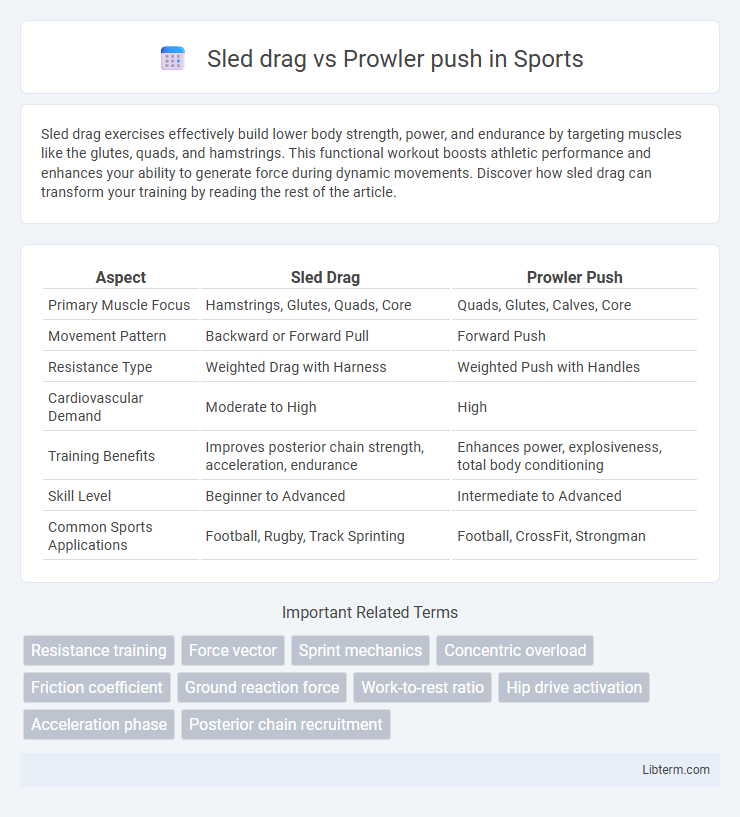Sled drag exercises effectively build lower body strength, power, and endurance by targeting muscles like the glutes, quads, and hamstrings. This functional workout boosts athletic performance and enhances your ability to generate force during dynamic movements. Discover how sled drag can transform your training by reading the rest of the article.
Table of Comparison
| Aspect | Sled Drag | Prowler Push |
|---|---|---|
| Primary Muscle Focus | Hamstrings, Glutes, Quads, Core | Quads, Glutes, Calves, Core |
| Movement Pattern | Backward or Forward Pull | Forward Push |
| Resistance Type | Weighted Drag with Harness | Weighted Push with Handles |
| Cardiovascular Demand | Moderate to High | High |
| Training Benefits | Improves posterior chain strength, acceleration, endurance | Enhances power, explosiveness, total body conditioning |
| Skill Level | Beginner to Advanced | Intermediate to Advanced |
| Common Sports Applications | Football, Rugby, Track Sprinting | Football, CrossFit, Strongman |
Understanding Sled Drag and Prowler Push
Sled drag and prowler push are two dynamic resistance training exercises targeting lower body strength and power development. Sled drags involve pulling a weighted sled towards the body, activating the hamstrings, glutes, and grip muscles, emphasizing unilateral movement and coordination. Prowler pushes require forcefully driving the sled away from the body, engaging the quads, calves, and core, enhancing explosive strength and anaerobic endurance.
Key Differences Between Sled Drag and Prowler Push
Sled drag primarily targets the hamstrings, glutes, and calves with a backward pulling motion that enhances posterior chain strength and power, whereas prowler push emphasizes the quadriceps, glutes, and core through a forward pushing movement that improves overall lower body explosiveness and conditioning. The sled drag often requires a stronger grip to maintain control during the pull, while the prowler push demands more upper body engagement for stabilization and drive. Training with sled drags increases eccentric strength and mobility, whereas prowler pushes focus on concentric force production and cardiovascular endurance.
Muscles Targeted: Sled Drag vs Prowler Push
Sled drag primarily targets the posterior chain muscles, including the glutes, hamstrings, and calves, as well as the lower back and core for stabilization. Prowler push emphasizes the quadriceps, glutes, and calves, engaging the core and upper body muscles like the shoulders and chest during the forward drive. Both exercises enhance lower body strength and conditioning but differ in muscle activation patterns due to the dragging versus pushing mechanics.
Strength and Power Development
Sled drag and Prowler push are effective for developing strength and power by targeting lower body muscles such as the glutes, quadriceps, and hamstrings through resistance training. Sled drags emphasize eccentric control and unilateral strength due to the drag force pattern, promoting enhanced muscle activation and stability. Prowler pushes generate higher concentric output and explosive power by requiring rapid, forceful propulsion, beneficial for athletic performance and sprint acceleration.
Conditioning and Endurance Benefits
Sled drag primarily targets lower body strength while significantly enhancing cardiovascular conditioning and muscular endurance through sustained resistance. Prowler push engages both upper and lower body muscles, offering a high-intensity, full-body workout that boosts anaerobic endurance and power output. Incorporating both exercises can improve overall work capacity, metabolic conditioning, and fatigue resistance.
Application for Athletes and General Fitness
Sled drag and Prowler push offer distinct benefits for athletes and general fitness enthusiasts by targeting different muscle groups and movement patterns. The sled drag emphasizes posterior chain strength, improving hamstrings, glutes, and lower back, making it ideal for sprinting and explosive power development. In contrast, the Prowler push engages the quadriceps, core, and cardiovascular system, enhancing overall conditioning, leg drive, and endurance for versatile athletic performance.
Suitability for Injury Prevention and Rehabilitation
Sled drag exercises offer controlled resistance that reduces joint strain, making them ideal for injury prevention and rehabilitation by promoting muscle activation without excessive load. Prowler push movements provide dynamic, multi-planar force, enhancing functional strength and cardiovascular endurance while allowing customizable intensity to accommodate recovery stages. Both modalities support safe progression, but sled drags emphasize stability and controlled movement, which benefits rehab protocols focused on joint protection and gradual strength rebuilding.
Programming Sled Drags and Prowler Pushes
Programming sled drags involves adjusting load, distance, and rest intervals to target strength, power, and endurance adaptations tailored to the athlete's goals. Prowler pushes require modulation of resistance and sprint duration to enhance explosive strength and anaerobic capacity while minimizing joint impact. Structuring these exercises within periodized plans maximizes hypertrophy, metabolic conditioning, and functional performance improvements.
Common Mistakes to Avoid
Common mistakes to avoid during sled drag or prowler push include improper posture, such as rounding the back or leaning too far forward, which can lead to injury and reduced efficiency. Failing to maintain consistent foot placement and stride length often results in uneven force distribution and decreased power output. Neglecting to engage the core and drive through the hips further diminishes performance and increases the risk of strain.
Which is Better: Sled Drag or Prowler Push?
Sled drag and prowler push both target lower body strength and conditioning, but sled drag emphasizes hamstrings and glutes by requiring backward pulling, while prowler push focuses more on quads through forward driving. The sled drag offers greater hip hinge activation and can improve sprint mechanics, whereas the prowler push tends to enhance explosive power and overall conditioning. Choosing between the two depends on specific training goals, with sled drag better for posterior chain development and injury prevention, and prowler push better for speed and anaerobic capacity.
Sled drag Infographic

 libterm.com
libterm.com